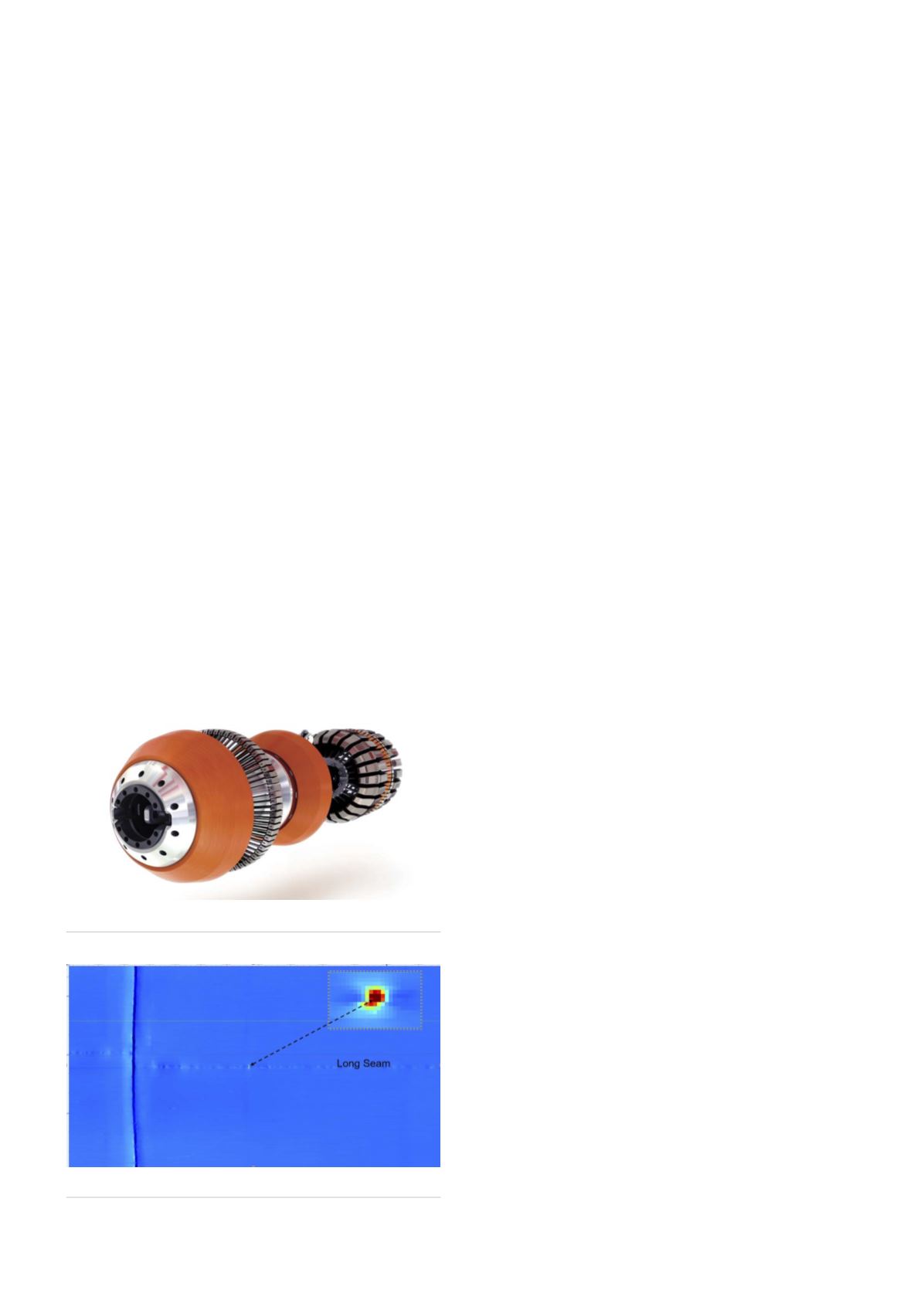
the pipeline operator closely monitors them for population
and activity growth along this segment, to help determine the
prioritisation of ILI assessments and results of each one.
When ENTEGRA was presented with the opportunity to
inspect this segment, the company began to ask questions about
its health, construction, location, cleaning and inspection history,
operating conditions and threats (both identified and suspected
unidentified threats). To help the company best approach the
project, ENTEGRA focused specifically on what the pipeline
operator needed to achieve in an intelligent inspection, as well as
the challenges, problems, and plans for the pipeline.
As part of ENTEGRA’s Project Management Standard, the
company worked with the pipeline operator to collect all
pipeline information and conduct a feasibility study. This 30 in.
natural gas pipeline segment is approximately 70 miles in length
and operates nearly 1000 psi. With the estimated pressure and
flow, wall thicknesses and bend information given, ENTEGRA
calculated a tool speed range of of 5 - 6 mph for the 30 in.
ENTEGRA UHR combination tool. Those speeds fall well within
specification for the tool and enable the company to achieve a
successful inspection with UHR quality data within the pipeline
operator’s specification. The pipeline was constructed with wall
thicknesses ranging from 0.625 in. to 0.375 in. As for bends, it was
confirmed that many of the bends were constructed back-to-
back and are 1.5D, which limits the navigability of many ILI tools
available on the market today.
This line had been previously inspected with another ILI
vendor’s multiple data set tool and appeared to have been a
degraded run. It is common to have ILI tool velocity challenges in
compressible products such as natural gas, and because of that,
degraded data in some areas is often the result. After reviewing
the results of the previous ILI inspection, it was clear that the
multiple data set tool struggled in the back-to-back 1.5D bends. It
therefore experienced speed excursions, thus limiting the quality
of the data it collected.
Once all pipeline information was collected and previous run
results were reviewed, ENTEGRA was able to conduct a feasibility
study and deem the project feasible. As part of the feasibility
study, the company also worked with the pipeline operator to
assess the risk of this ILI project. ENTEGRA ranked the severity
of possible occurrence of events such as safety concerns, stuck
tool, degraded data, tool damage, etc. over the likelihood of
them happening. Based on the results of the feasibility study, risk
assessment, and comparisons to ENTEGRA’s UHR tool capabilities,
it was decided to move forward with the inspection of the high-
profile pipeline segment with the company’s UHR MFL/CAL/IMU
tool.
The project’s aim
From the pipeline operator’s perspective, the main objective of
this ILI project was to get ENTEGRA’s UHR tool from launcher to
receiver without disrupting the flow of the pipeline, and without
sacrificing data quality in the process. More specifically, the
objective was to obtain trustworthy MFL, Caliper, and mapping
data on all sections of the pipe that was found to be degraded
from the previous vendor’s ILI attempt, and to allow the pipeline
operator to compare and confirm all findings. In order to do so,
the pipeline had to be prepared for the inspection.
As part of the progressive pigging plan built to obtain
successful ILI, ENTEGRA first started with cleaning and gauging
of the pipeline. After a series of pipeline cleaning runs and the
evaluation of them, the pipeline was deemed clean enough to
run the ILI tool. Prior to the launch of the ILI tool, the company
ran a gauging tool to confirm the navigability of the pipeline
compared to the specification of ENTEGRA’s 30 in. ILI tool. The
gauge plate was sized to replicate the minimum ID or maximum
collapsibility of the UHR ILI tool and perform a final check
(or proving run) to confirm all valves are fully opened, and no
unexpected deformation exists that would prevent the ILI tool
from navigating the pipeline successfully. Additionally, the gauge
tool run acted as a trial for the ILI tool to assure the pipeline
operation was suitable for the ILI tool’s expected speed.
After completion of all pre-ILI steps, the ILI tool was loaded
into the launcher, seated in the nominal pipe, and successfully
launched through the mainline valve and into the pipeline. The
30 in. tool navigated the entire 70 mile segment without any
issues at the expected 5 - 6 mph tool speed. In due course,
ENTEGRA’s UHR MFL/CAL/IMU tool was received with no
damage and in the expected time frame. Preliminarily in the field
(prior to demobilisation) and after a tool functionaality test, the
tool was confirmed to have achieved 100% sensor coverage on
all data sets through the entire length of the segment, without a
tool overspeed.
Like all other ILI projects, getting tools through pipelines
is only half of the objective. The other half is successfully and
accurately capturing, analysing, and reporting the data back to
the operator, so it can be prioritised and acted upon. After the
successful completion of the ILI run, the data was transferred
to ENTEGRA’s Global Technology Centre for analysis. Within
Figure 1.
ENTEGRA’s 30 in. UHR ILI tool.
Figure 2.
Corrosion on the long seam weld.
70
World Pipelines
/
MARCH 2020








